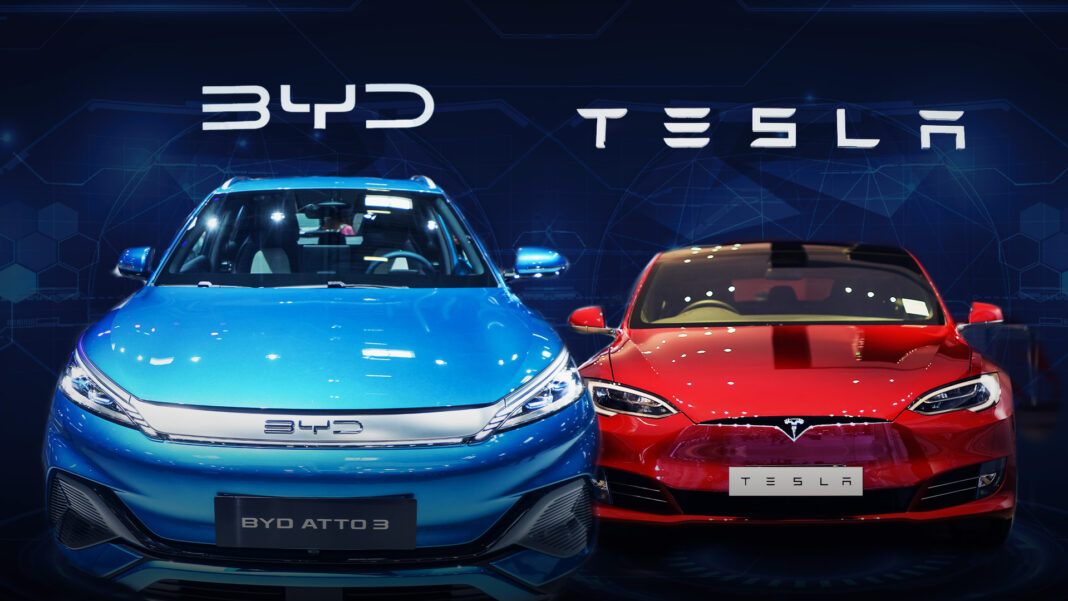The electric vehicle world is shifting faster than ever before, and two names constantly come up in the conversation: Tesla and BYD. These giants from opposite ends of the globe have carved unique paths in the EV space—Tesla, the American trailblazer, and BYD, the Chinese powerhouse rising steadily with every passing year. The question on many minds now is simple yet thrilling: could BYD be catching up to, or even overtaking, Tesla when it comes to innovation?
Let’s begin with the numbers—though they only tell part of the story, they reveal a powerful trend. In 2024, BYD stunned the market by selling approximately 4.27 million new energy vehicles, which include both fully electric and plug-in hybrid cars. Of these, nearly 1.76 million were fully electric, putting them toe-to-toe with Tesla’s 1.79 million deliveries in the same period. The race is close—so close that it’s becoming less about the gap and more about momentum. BYD’s meteoric rise signals a brewing shift, hinting that Tesla might not remain the EV world’s undisputed king forever.
But while numbers spark interest, pricing ignites mass appeal. This is where BYD excels. Their cars, generally priced between $25,000 and $50,000, are designed with accessibility in mind. They aim for the middle class, for people who want a reliable, sustainable ride without sacrificing financial sanity. Tesla, in contrast, continues to brand itself as a premium automaker. Its starting point hovers around $48,000 for a Model 3, and its high-end offerings—like the Model S and Model X—can exceed $105,000. The Plaid variants, known for blistering acceleration, are coveted by performance enthusiasts but remain out of reach for the average buyer. Essentially, while Tesla dazzles, BYD democratizes.
The paths these automakers take in technology are equally fascinating. BYD, for instance, has bet heavily on its own blade battery technology. These lithium iron phosphate (LFP) batteries are designed with safety and durability at their core, charging quickly while staying cool under pressure. Tesla has taken a different route. Its nickel-based lithium-ion batteries pack more energy, granting longer ranges on a single charge. The company is also deep into developing the 4680 battery cell, a next-generation component meant to push performance and efficiency even further.
Self-driving tech adds another dimension to their rivalry. Tesla’s Full Self-Driving (FSD) system has dominated headlines and debates. While still controversial and imperfect, it represents one of the most ambitious efforts to redefine what a “driver” even means. BYD, meanwhile, has been crafting its own advanced driving system called “God’s Eye”—a name that feels borrowed from a spy thriller. Although Tesla’s FSD is still considered ahead, BYD’s system is evolving fast, and with each iteration, the distance between the two narrows.
A significant part of BYD’s strength lies in its vertical integration. The company produces many of its own parts, from batteries to semiconductors, giving it greater control over quality and cost. Tesla, although renowned for its exceptional software and over-the-air updates that improve vehicles long after they’ve been delivered, still relies more on third-party suppliers. Each model has its strengths, but in a world where supply chains are volatile, BYD’s in-house approach may prove more resilient.
External forces are also reshaping the competition. Tesla experienced a notable 13% decline in vehicle deliveries in the first quarter of 2025, a drop that amounted to roughly 50,000 vehicles. This downturn has been attributed to growing competition in the EV space, but also to political turbulence surrounding Elon Musk himself. Following the U.S. elections, rumors swirled about Musk potentially joining the government—an idea that polarized public opinion and may have tarnished the brand’s image in the short term. For BYD, this may be a moment to seize attention and mindshare from disillusioned Tesla fans.
Nowhere is BYD’s confidence more visible than in the launch of its supercar, the U9. With bold styling, a futuristic cabin, and jaw-dropping performance, the U9 isn’t just a car—it’s a statement. It proves that BYD isn’t content with just making affordable EVs; they want to play in every league, including the elite world of high-performance machines. In a moment that turned heads around the world, global superstar streamer IShowSpeed traveled to China, explored the brand’s top models like the Yangwang U8, and reportedly bought a U9 for a cool $250,000.
The U9 isn’t just about looks—it’s fast, smart, and efficient. Its motor delivers the kind of raw power one would expect from a gas-guzzling exotic, while its smart aerodynamics and advanced battery management ensure both speed and stability. It’s road-ready, and it’s already making waves.
Compare that to Tesla’s much-hyped Roadster, which, after eight long years, still hasn’t made it into customers’ garages. Fans have waited—and waited—as Tesla’s promises have shifted, delayed, or gone quiet. Despite bold claims about top speeds and next-gen features, the Roadster remains a phantom on the horizon. Meanwhile, BYD’s U9 is here, now, real. In the world of innovation, showing up on time can be the biggest flex of all.
The release of the U9 sends a powerful message: BYD isn’t chasing Tesla. They’re carving their own lane—and now, they’ve joined the conversation at the supercar table.
So, who’s winning this race? It depends on where you’re standing. Tesla still leads in many categories—self-driving software, range efficiency, brand prestige. But BYD is surging with strength in production, pricing, safety, and an increasingly compelling line-up. They’ve gone from a local champion to a global force, and if current trends hold, they may soon be leading the next chapter in the electric revolution.
In the end, this competition is more than just Tesla versus BYD. It’s about progress. It’s about a world where clean, intelligent, exciting cars are not the exception, but the norm. And as the old saying goes, “necessity is the mother of invention.” With the planet at stake and consumers demanding more, both brands are pushing each other—and the entire industry—toward a better, greener future.




